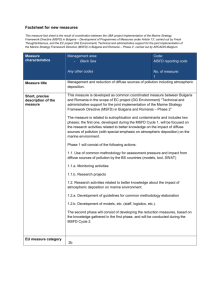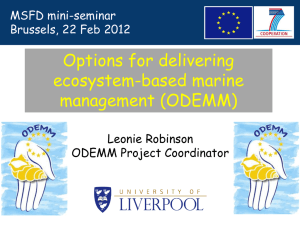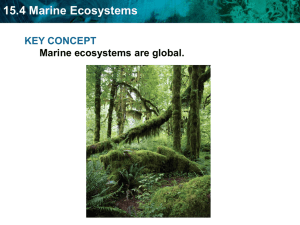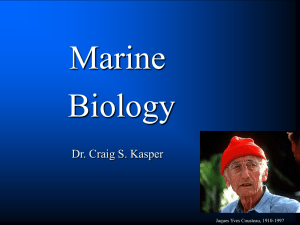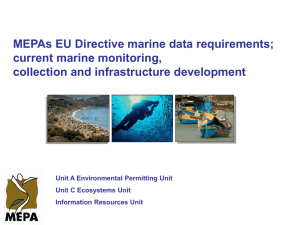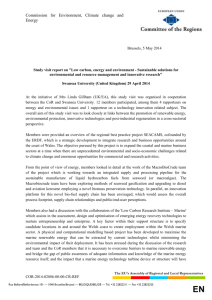Synergies between the Water Framework Directive
advertisement
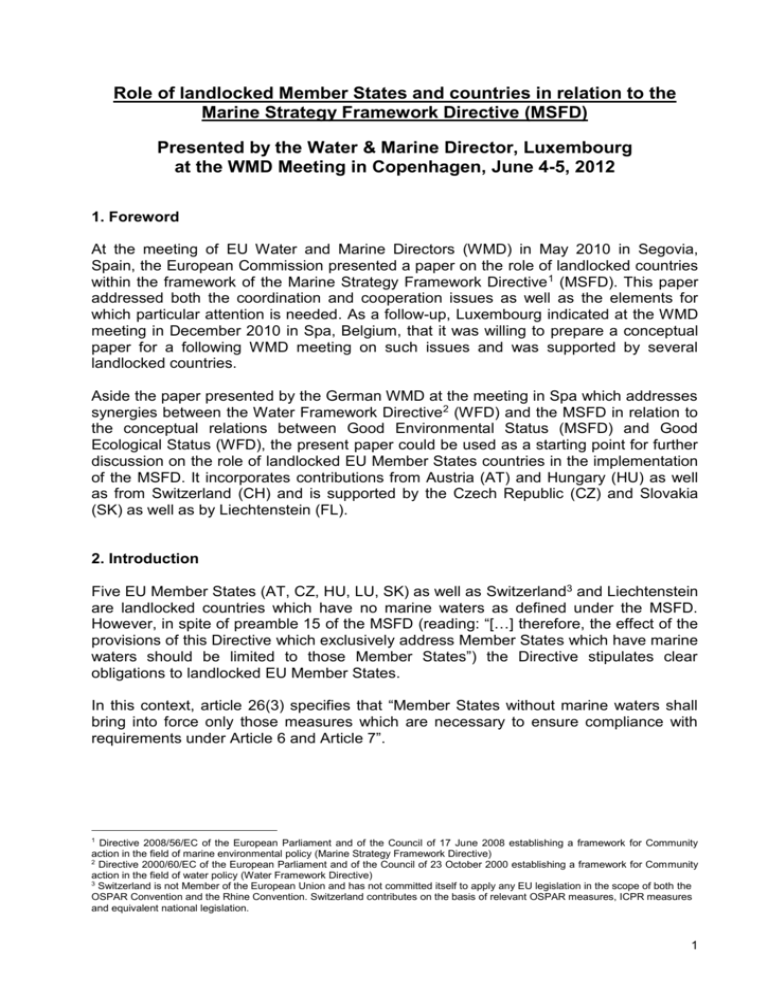
Role of landlocked Member States and countries in relation to the Marine Strategy Framework Directive (MSFD) Presented by the Water & Marine Director, Luxembourg at the WMD Meeting in Copenhagen, June 4-5, 2012 1. Foreword At the meeting of EU Water and Marine Directors (WMD) in May 2010 in Segovia, Spain, the European Commission presented a paper on the role of landlocked countries within the framework of the Marine Strategy Framework Directive 1 (MSFD). This paper addressed both the coordination and cooperation issues as well as the elements for which particular attention is needed. As a follow-up, Luxembourg indicated at the WMD meeting in December 2010 in Spa, Belgium, that it was willing to prepare a conceptual paper for a following WMD meeting on such issues and was supported by several landlocked countries. Aside the paper presented by the German WMD at the meeting in Spa which addresses synergies between the Water Framework Directive2 (WFD) and the MSFD in relation to the conceptual relations between Good Environmental Status (MSFD) and Good Ecological Status (WFD), the present paper could be used as a starting point for further discussion on the role of landlocked EU Member States countries in the implementation of the MSFD. It incorporates contributions from Austria (AT) and Hungary (HU) as well as from Switzerland (CH) and is supported by the Czech Republic (CZ) and Slovakia (SK) as well as by Liechtenstein (FL). 2. Introduction Five EU Member States (AT, CZ, HU, LU, SK) as well as Switzerland3 and Liechtenstein are landlocked countries which have no marine waters as defined under the MSFD. However, in spite of preamble 15 of the MSFD (reading: “[…] therefore, the effect of the provisions of this Directive which exclusively address Member States which have marine waters should be limited to those Member States”) the Directive stipulates clear obligations to landlocked EU Member States. In this context, article 26(3) specifies that “Member States without marine waters shall bring into force only those measures which are necessary to ensure compliance with requirements under Article 6 and Article 7”. 1 Directive 2008/56/EC of the European Parliament and of the Council of 17 June 2008 establishing a framework for Community action in the field of marine environmental policy (Marine Strategy Framework Directive) 2 Directive 2000/60/EC of the European Parliament and of the Council of 23 October 2000 establishing a framework for Community action in the field of water policy (Water Framework Directive) 3 Switzerland is not Member of the European Union and has not committed itself to apply any EU legislation in the scope of both the OSPAR Convention and the Rhine Convention. Switzerland contributes on the basis of relevant OSPAR measures, ICPR measures and equivalent national legislation. 1 3. Regional cooperation and collaboration structures Article 6 of the MSFD addresses the cooperation and coordination arrangements that need to be in place in order to comply with the MSFD obligations. Regional Sea Conventions are specifically addressed in this context as they play a major role in most domains and elements related to the MSFD. The landlocked EU Member States’ inland waters are draining into the marine regions Baltic Sea, North-East Atlantic Ocean and Black Sea, Switzerland being as well related to the Mediterranean Sea. In this context it is important to note that Luxembourg is the only landlocked EU Member State that is party of a regional Sea Convention, i.e., OSPAR (which Switzerland is party to as well) which is mainly a consequence of the historical implications of OSPAR in the elaboration of strategies aiming at the reduction of pollution from nutrients, hazardous and radioactive substances from both point and diffuse land-based sources. According to article 1, the purpose of the WFD is “to establish a framework for the protection of inland surface waters, transitional waters, coastal waters and groundwater” which contributes, inter alia, to “the protection of […] marine waters” and aims “to prevent and eliminate pollution of the marine environment” and “to cease or phase out discharges, emissions and losses of priority hazardous substances, with the ultimate aim of achieving concentrations in the marine environment near background values for naturally occurring substances and close to zero for man-made synthetic substances”. The WFD calls in article 3(4) on Member States to “ensure, that the requirements of this Directive for the achievement of the environmental objectives established under article 4, and in particular all programmes of measures are coordinated for the whole of the river basin district”. In this perspective the cooperation structures implicated in the implementation of the WFD at river basin district level, especially the international river commissions, should play a crucial role in relation to achieve the common targets of both the MSFD and the WFD. All EU landlocked Member States as well as Switzerland and Liechtenstein are indeed involved in one or more of the relevant international river commissions which exist in the international river basin districts of the Danube (International Commission for the Protection of the Danube River), Elbe (International Commission for the Protection of the Elbe), Meuse (International Meuse Commission), Odra (International Commission for the Protection of the Odra River against Pollution) and Rhine (International Commission for the Protection of the Rhine) rivers. For this reason several international river commissions have already put the MSFD on the agenda of their working activities in line with the requirements referred to in the 3rd paragraph of article 6(2) of the MSFD. In addition several international river commissions and regional sea conventions have cooperation agreements in place which will be as well a support towards better implementation of WFD and MSFD goals. 4. Elements of the MSFD for which particular attention is needed from landlocked countries Marine Strategies are the key elements of the MSFD. In this context particular attention from landlocked Member States is needed when it comes to establish a comprehensive 2 set of environmental targets and associated indicators according to article 10 as well as the elaboration of the programmes of measures according to article 13. It is obvious that article 11(6) of the WFD has a similar goal as the MSFD when stipulating that “Member States shall take all appropriate steps not to increase pollution of marine waters” and the respective measures are elements of the River basin management plans (RBMP) according to part A, point 7.11 of Annex VII of the WFD. Thus, in relation to the programmes of measures, synergies between both directives are obvious. In relation with the Commission Decision 2010/477/EU4 which sets the criteria and methodological standards on good environmental status of marine waters, four key issues are of particular relevance to landlocked Member States: 1. 2. 3. 4. Abundance/distribution of key trophic groups/species, including, where appropriate, long-distance anadromous and catadromous migrating species (Descriptor 4.3); Minimising human-induced eutrophication (Descriptor 5); Concentration of contaminants (Descriptor 8); Marine litter (Descriptor 10). 4.1 Long-distance anadromous and catadromous migrating species River basin management plans elaborated according to article 13 of the WFD address river continuity issues aiming at restoring habitats and mitigating migratory obstacles for long-distance anadromous (e.g., salmon) and catadromous (e.g., eel) migrating species. In addition to the RBMP, the eel management plans foreseen by the EU Eel regulation 5 address, where appropriate, comparable measures. In order to guarantee an overall success in this context, it is important that these efforts at land are mirrored by appropriate measures by marine countries at sea and within coastal waters. 4.2 Minimising human-induced eutrophication With regard to nutrients, e.g., nitrogen and phosphorus, well established provisions are in place within EU (water) legislation that aim at reducing emissions both from point and diffuse sources, e.g., the EU Urban Wastewater Treatment Directive6, the EU Nitrates Directive7 and the EU “phosphorus in detergents” Regulation8. In this context, the Guidance Document on Eutrophication Assessment (Eutrophication assessment in the context of European water policies) adopted by WD at their meeting in May 2009 in Brno, Czech Republic, needs to be referred to as well. 4 Commission Decision 2010/477/EU of 1 September 2010 on criteria and methodological standards on good environmental status of marine waters 5 Council regulation (EC) No 1100/2007 of 18 September 2007 establishing measures for the recovery of the stock of European eel 6 Council Directive 91/271/EEC of 21 May 1991 concerning urban waste-water treatment 7 Council Directive 91/676/EEC of 12 December 1991 concerning the protection of waters against pollution caused by nitrates from agricultural sources 8 Regulation (EU) No 259/2012 of the European Parliament and of the Council of 14 March 2012 amending the Regulation (EC) No 648/2004 as regards the use of phosphates and other phosphorus compounds in consumer laundry detergents and consumer automatic dishwasher detergents 3 The EU Nitrates Directive stipulates measures to be taken for reducing water pollution caused or induced by nitrates from agricultural sources, respectively for preventing further such pollution, inter alia whenever estuaries, coastal waters or marine waters are found to be eutrophic, respectively may become eutrophic, if no action is taken (Annex I). A very similar approach is in place for the EU Urban Wastewater Treatment Directive, where enhanced treatment is needed in the catchment area, inter alia of estuaries, coastal waters or marine waters, if these waters are already eutrophic or may become eutrophic if no protective action is taken (Annex IIA). Hence it is assumed that measures taken under the WFD including the EU Nitrates Directive and the EU Urban Wastewater Treatment Directive will contribute to reaching Good Environmental Status under the MSFD for those human pressures whose main source are land-based activities. Furthermore the recently adopted EU “phosphorus in detergents” Regulation aiming at reducing the phosphorus content in consumer laundry detergents and consumer automatic dishwasher detergents will contribute additionally to achieve Good Environmental Status under the MSFD by eliminating those substances at product level even though these measures are not directly linked to Member States’ programmes of measures. 4.3 Concentrations of contaminants at levels not giving rise to pollution effects The EU Environmental Quality Standards (EQS) Directive9 defines concentrations of priority and priority hazardous substances in surface waters that will cause no harm to aquatic ecosystems regulated by the EU WFD. It is obvious that both the EQS Directive and the currently negotiated proposal for its amendment mainly focus on environmental quality standards for freshwater. However, the marine aquatic ecosystems may require additional substances of concern and / or more restrictive concentration levels than those agreed upon for the freshwater aquatic environment. In a sense of solidarity, landlocked Member States would see it to be a key prerequisite that they were associated to the process at the earliest possible stage when more stringent criteria are going to be fixed in relation to contaminants within the MSFD. Alternatively marine criteria could as well be taken into account when the EQS Directive was to be amended in future. Furthermore the European chemicals policy REACH10 will contribute additionally to achieve Good Environmental Status under the MSFD by phasing out stepwise substances of very high concern in addition to Member States’ programmes of measures related to reduce the input of contaminants. 9 Directive 2008/105/EC of European Parliament and of the Council on environmental quality standards in the field of water policy, amending and subsequently repealing Council Directives 82/176/EEC, 83/513/EEC, 84/156/EEC, 84/491/EEC, 86/280/EEC and amending Directive 2000/60/EC 10 Regulation (EC) No 1907/2006 of the European Parliament and of the Council of 18 December 2006 concerning the Registration, Evaluation, Authorisation and Restriction of Chemicals (REACH), establishing a European Chemicals Agency, amending Directive 1999/45/EC and repealing Council Regulation (EEC) No 793/93 and Commission Regulation (EC) No 1488/94 as well as Council Directive 76/769/EEC and Commission Directives 91/155/EEC, 93/67/EEC, 93/105/EC and 2000/21/EC 4 4.4 Properties and quantities of marine litter The distribution of litter in the marine waters is highly variable. As a consequence Descriptor 10 on marine litter within the Commission Decision 2010/477/EU indicates that “it is necessary to identify the activity to which it is linked including, where possible, its origin”. Studies and reports such as JRC Report on Marine Litter from 201111 and GESAMP Report No. 82 from 201012 indicate that one amongst other land-based sources of marine litter is riverine input of e.g., micro-particles. However, there is still a need for further analysis, notably relating to micro-particles input sources as well as for an enhanced assessment of their potential toxicity. In the light of the above mentioned considerations, late involvement might lead to severe financial consequences for upstream landlocked countries. Thus, an early association to the processes leading to the setting of targets for good status as well as to the identification of the measures is of utmost importance when the implementation of the MSFD should be successful. Conclusions: a) Rely on river commissions as appropriate coordination and collaboration bodies for landlocked issues Both landlocked Member States as well as Switzerland and Liechtenstein and marine Member States are party to such river commissions which could thus be helpful tools in the context of coordination and collaboration. Member States with marine waters are invited to mention their efforts on cooperation and collaboration within river commissions in their MSFD 2012 Reports. b) Associate landlocked Member States and invite Liechtenstein and Switzerland at an early stage when fixing environmental targets Nutrient as well as contaminants load reduction from land-based diffuse and point sources into the marine aquatic environment should rely on the existing water related EU legislation, i.e., the WFD, Nitrates, Urban Wastewater Treatment, Environmental Quality Standards Directives as well as the Phosphorus in detergents and REACH Regulations. In this context (as well as any other issue where action from landlocked countries may be requested), landlocked Member States as well as river commissions would be associated at an early stage before targets are set. Liechtenstein and Switzerland would be invited as observers to this process. 11 Marine Litter, Technical Recommendations for the Implementation of MSFD Requirements by MSFD GES Technical Subgroup on Marine Litter in JRC Scientific and Technical Reports, EUR 25009 EN – 2011, Publications Office of the European Union, Luxembourg (2011) 12 Proceedings of the Joint Group of Experts on the Scientific Aspects of Marine Environmental Protection (GESAMP) Workshop on Microplastic particles, GESAMP Reports and Studies No. 82, UNESCO-IOC, Paris (2010) 5
